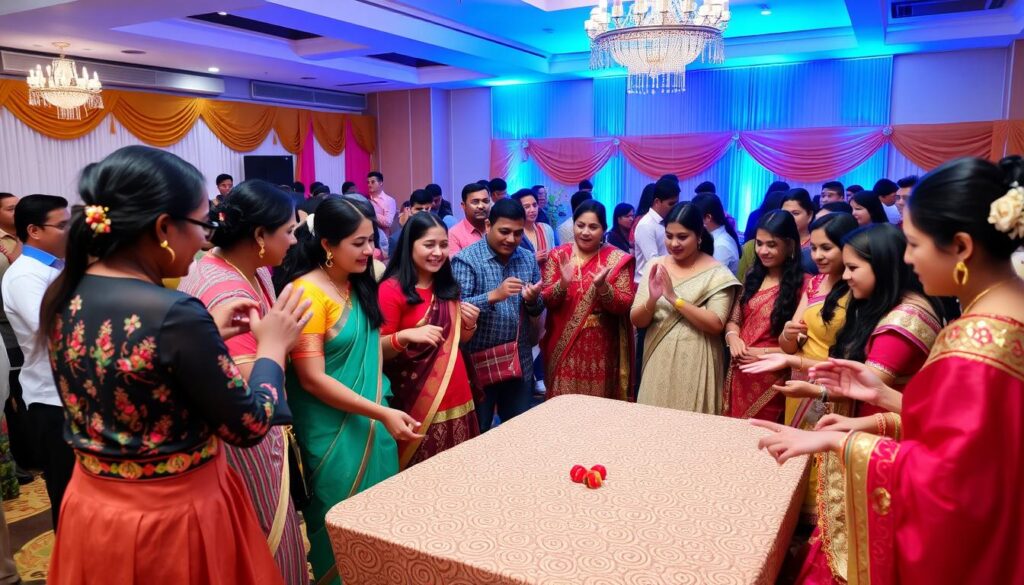Hosting a successful event often hinges on creating a welcoming and engaging atmosphere from the very start. That’s where Reception Games That Break the Ice come into play. These fun, interactive activities are designed to help guests mingle, connect, and feel comfortable in the company of strangers. By incorporating well-planned icebreaker games into your event itinerary, you can foster a sense of camaraderie and encourage meaningful conversations that set the tone for an unforgettable experience.
Whether you’re planning a corporate gathering, a wedding reception, or a community event, strategically chosen Reception Games That Break the Ice can be a game-changer. Not only do they help attendees overcome initial shyness and awkwardness, but they also stimulate active participation, spark laughter, and create shared memories that bring people together. In this comprehensive guide, we’ll explore the essential elements of successful warm-up activities, offer practical tips for organizing interactive introductions, and provide a wealth of ideas for Fun Icebreakers that cater to diverse age groups and venues.
Understanding the Importance of Reception Games That Break the Ice
Organizing warm-up activities and get to know you games for receptions is more than just a fun icebreaker. These interactive exercises hold immense value in creating a welcoming and inclusive environment for all attendees. By breaking the ice, these activities help reduce anxiety and encourage participants to interact with one another, fostering a positive atmosphere for networking and socializing.
When guests feel at ease and engaged from the start, they are more likely to actively participate in the event and make meaningful connections. Get to know you games and warm-up activities serve as a catalyst, enabling participants to step out of their comfort zones, share personal information, and find common ground with strangers. This, in turn, lays the foundation for more authentic and productive exchanges throughout the reception.
Furthermore, these interactive games promote inclusivity by ensuring that everyone, regardless of their background or familiarity with the event, has an opportunity to engage and feel welcome. This fosters a sense of community and belonging, which can be especially important for first-time attendees or those who may feel uncertain in social settings.
Ultimately, the strategic use of reception games that break the ice can significantly enhance the overall experience and outcomes of a reception, making it a valuable investment for organizers and attendees alike.
Essential Elements of Successful Warm-up Activities
When it comes to planning successful reception games that break the ice, certain essential elements must be considered. Simplicity is key – the best Team Building Games and Interactive Introductions are easy to understand and execute, allowing participants to focus on engaging with one another rather than deciphering complex rules.
Engagement is another crucial factor. Activities should be designed to actively involve everyone, encouraging participation and fostering a sense of shared experience. Relevance to the event theme can also enhance the effectiveness of warm-up games, creating a more cohesive and meaningful experience for attendees.
Adaptability is also essential, as reception games need to be able to accommodate different group sizes and dynamics. Versatile activities that can be tailored to the specific needs of each event are more likely to succeed in creating a comfortable and inclusive environment for all participants.
By incorporating these essential elements into the planning process, event organizers can ensure that their warm-up activities effectively set the tone for a memorable and engaging event, where attendees can interact, bond, and have fun from the very start.
Quick and Easy Get to Know You Games for Large Groups
When organizing events for large gatherings, it’s important to have a repertoire of quick and engaging icebreaker games to help attendees mingle and connect. These Networking Games and Lighthearted Energizers can be easily implemented to foster a warm and collaborative atmosphere.
One such game is the “Two Truths and a Lie.” Participants introduce themselves and share two true facts about themselves, along with one fabricated statement. The rest of the group then tries to guess which statement is the lie. This simple yet effective game encourages participants to share a bit about themselves in a fun and interactive way.

Another crowd-pleaser is the “Human Bingo” game. Participants are given a bingo-style card with various characteristics, such as “speaks three languages” or “has traveled to five continents.” They then circulate the room, introducing themselves and finding others who match the characteristics on their card. This game not only helps participants learn more about each other but also promotes active mingling and engagement.
These Lighthearted Energizers are just a few examples of the many quick and easy get-to-know-you games that can be used to liven up large group events. By incorporating these simple activities, event organizers can create a welcoming and inclusive environment that encourages attendees to connect and build lasting relationships.
Planning Interactive Introductions for Different Age Groups
When it comes to First Impression Games and Rapport Building Exercises, it’s crucial to tailor your approach to the specific age group you’re working with. Children, for instance, may respond better to lively, fast-paced activities that encourage physical participation, while seniors might prefer more contemplative, discussion-based exercises.
For younger audiences, consider simple but engaging games like “Two Truths and a Lie,” where participants share a mix of factual and fictional information about themselves, and the group has to guess which is the lie. This helps break the ice and fosters a sense of curiosity and connection. Alternatively, “Find Someone Who” prompts participants to mingle and discover common interests or experiences, building camaraderie in a fun, low-pressure way.
For older age groups, focus on activities that encourage storytelling and shared experiences. “What’s in a Name?” allows participants to explore the significance of their names, while “Timeline Sharing” invites individuals to share meaningful moments from their lives. These types of First Impression Games and Rapport Building Exercises help cultivate a deeper understanding and appreciation for one another’s diverse backgrounds and perspectives.
Regardless of the specific age group, the key is to create a welcoming and inclusive environment where everyone feels comfortable participating. By adapting your approach to the unique needs and preferences of each audience, you can ensure that your First Impression Games and Rapport Building Exercises effectively foster meaningful connections and set the stage for a successful event or gathering.
Team Building Games That Foster Collaboration
When it comes to planning reception games, team-building activities that promote collaboration can be particularly effective in breaking the ice and fostering strong group dynamics. These fun icebreakers not only help participants get to know one another but also encourage problem-solving, communication, and a sense of camaraderie.
One engaging team-building game is the “Marshmallow Challenge,” where groups must work together to build the tallest free-standing structure using only marshmallows and spaghetti. This activity requires creativity, strategic thinking, and compromise, as team members must collaborate to achieve their goal. Another popular option is the “Blindfold Challenge,” where participants are paired up and one is blindfolded, relying on their partner’s guidance to navigate a series of obstacles.
These reception games that break the ice not only get everyone involved but also help build trust, strengthen relationships, and improve overall group dynamics. By incorporating these team-building activities into your event, you can create a welcoming and engaging atmosphere that sets the stage for a successful and memorable gathering.
Incorporating Cultural Sensitivity in Reception Games
When planning get to know you games and warm-up activities for diverse groups, it’s crucial to consider cultural sensitivity. The games you choose should be inclusive, avoiding potentially offensive or exclusionary content. This helps create a welcoming environment where all participants feel comfortable and respected.
One effective strategy is to select activities that celebrate the unique backgrounds and experiences of your attendees. For example, you could have participants share a traditional greeting or piece of their cultural heritage. This encourages learning and appreciation, fostering a sense of community.

It’s also important to avoid games that rely heavily on language or cultural references that may be unfamiliar to some. Opt for activities that are simple, engaging, and require minimal prior knowledge. This levels the playing field and ensures everyone can participate fully.
By incorporating cultural sensitivity into your reception games, you can create a warm and inclusive atmosphere that sets the tone for a successful event. This small but impactful step can go a long way in making all attendees feel valued and connected from the very start.
Timing and Flow: Organizing Your Game Sequence
Crafting a seamless and engaging game sequence is crucial for an event’s success. When planning your Team Building Games or Interactive Introductions, consider the optimal timing and flow to maintain energy and enthusiasm throughout the proceedings.
Begin by assessing the overall duration of your event. Allocate specific time slots for your games, ensuring they don’t overwhelm the schedule. Aim for a balanced mix of shorter, quick-paced activities and lengthier, more immersive ones. This variety will keep participants on their toes and prevent any lulls in the energy levels.
Transitions between games are equally important. Smooth transitions help maintain the momentum and prevent awkward pauses. Thoughtfully design your sequence, allowing for natural breaks and opportunities to regroup. Incorporate icebreakers at the start to set the tone, followed by more involved Team Building Games as the event progresses.
Remember, the timing and flow of your game sequence can significantly impact the overall event experience. With careful planning and a keen eye for pacing, you can create a memorable and enjoyable atmosphere for all participants.
Equipment and Materials Needed for Successful Games
Organizing captivating Networking Games and Lighthearted Energizers requires thoughtful planning, including compiling the right equipment and materials. From simple items like sticky notes and markers to specialized props, having the necessary supplies on hand can make the difference between a seamless event and a disorganized one.
Start with the basics – pens, paper, and name tags. These foundational elements facilitate easy introductions and note-taking during activities. Consider also having a timer or stopwatch to keep the games flowing at an engaging pace. For more interactive Networking Games, items like balls, balloons, or scarves can add an element of playfulness and physical interaction.
If you’re planning Lighthearted Energizers that require more specialized equipment, don’t be afraid to get creative. Hula hoops, jump ropes, and even beach balls can transform a room and get participants moving. Remember, the key is to select materials that align with your game choices and complement the overall event theme and atmosphere.
Regardless of the specific items needed, be sure to have backups on hand and consider budget-friendly alternatives. This ensures you’re prepared for any unexpected situations and can deliver a seamless, memorable experience for your guests.
Adapting Games for Different Venue Types and Spaces
When planning first impression games and rapport building exercises, it’s crucial to consider the unique characteristics of the event venue. From intimate conference rooms to expansive outdoor spaces, the setting can significantly impact the flow and effectiveness of your activities. By thoughtfully adapting your games to the available space, you can ensure a seamless and engaging experience for all participants.
In a small, confined room, icebreakers that encourage close interaction and personal sharing may work best, fostering a sense of community. On the other hand, larger environments call for games that allow participants to move around freely, promoting mingling and energetic exchange. Outdoor events present additional considerations, such as accommodating varying weather conditions and providing clear boundaries for activities.
Regardless of the venue, maintaining energy and enthusiasm is key. Modifying the pace, instructions, and physical setup of the games can help you create an inviting atmosphere where everyone feels comfortable participating. By staying attuned to the unique needs of each event space, you can unlock the full potential of your First Impression Games and Rapport Building Exercises, setting the stage for meaningful connections and a memorable start to the occasion.









